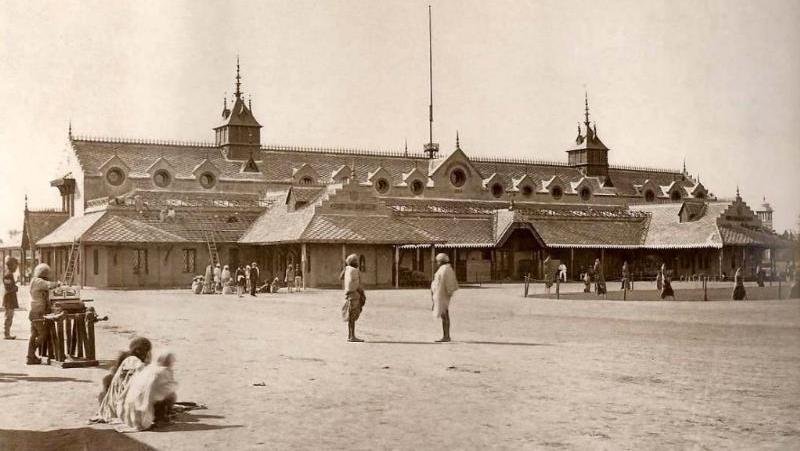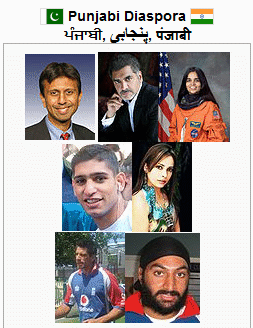
Many times there has been an interesting question that is raised in academic circles, "How did the miniscule population from Europe, not only controlled, but also ruled, over the greater majority of their colonies?"
One reason that scholars have pointed out is that beyond the military and political control, the rule of the European imperialist countries extended and penetrated deep into the psyche of a common man in their colonies, making him accept the superiority of 'value' system of Europe over its native tradition. More than its legal authority, the control of Europe and so called 'West', extended to enslave the minds of their colonial population. Beyond providing a political and economic governance, European interaction with their colonies in east brought about a fresh wave of meanings to society and culture that influenced their native language, music, art, religion, education, law, justice, economic system, architecture, medicine, technology and traditional value system. For executing Divide and Rule, it is important to first divide the psyche of a common man. Division is nothing but a subjective phenomenon that creates smaller independent units from a larger group. In order to create independent smaller units, it is important to construct some kind of boundaries of each unit and identify a relationship within the unit and that can be used as a symbol of 'identity' of that unit. The persuasions used for creation of these boundaries included, race-caste, language, religious group, geographical location etc. Each smaller unit carries a psyche of common connection within a group and comparison with other different groups and that becomes central nervous system of 'Division'.
The colonies under the European governance became easy preys of calculated political dialectics, where every unit with the colony initiated a practice of self introspection of their socio-cultural setup in order to locate their identity, instead of providing any resistance to the colonial power. In this passage, I shall try to discuss the various measures of British political strategy and its impact in transforming the thinking pattern of Punjabi psyche vis-à-vis the so called western society and culture.
"The Punjaub has been occupied by our troops, but it is not conquered" noted Charles Napier, commander-in-chief of British forces in November 1849, after the last Anglo-Sikh war. Here, we must note that the dictionary meaning of 'occupied' and 'conquered' is not very distinct. The point that Napier wants to make, reflects his sense of confidence to rule the land of Punjab. Perhaps, Napier's understanding that is rooted in British military and political strategy towards its colony exhibits that in order to 'conquer', a land, it is important is to capture the mind and psyche of her inhabitants.
Language is perhaps, the root that gears the functioning of human mind. Language has two different ways in which it operates as a mode of communication. The first is the objective mode and the second is subjective. The objectivity of language primarily carries its significance to transmit the data or logic in its usage. A secular mind comprehends the significance of language merely as a mode of transmission to convey the objective data contained in it. In other words, an objective mind comprehends the importance of language as a carrier or mode of transportation, of a message.

The depth and sensitivity of a language is an important aspect that builds conceptions and thinking pattern of human psyche. Before reading a language, its music flows like its blood into the structure of its script. Script carries its weight in its shapes, sizes and continuity. More of that can be understood from the works of the Islamic calligraphers, who have established calligraphy not merely an art of writing beautiful words, but an expression of devotion towards the Prophet.
Coming back, the British understood that language constructs structures of ideology of a society and therefore was an important subject to handle within the colonies. Therefore, there were different language policies that were adopted by the British and especially in Punjab where Urdu was the official language after Persian, even though Punjabi was the language of the masses. In her book, "The Social Space of Language- Vernacular culture in British Colonial Punjab", Dr. Farina Mir examines the role of language policy in underpinning the identity-based politics among the masses. She appraises to a great depth how the language policy of the British was associated to a particular religion in India and specifically in Punjab.
With the background of their experience in Europe, the British came to Punjab and brought new definition of a nation to their colonies. Since the geographies of European nations were divided primarily on linguistic basis, the British emphasized that different nations in India, belong to different geographies and possess different languages, culture, customs, traditions and religion. The newer definition helped to propagate the colonial interests, as the people of India were sensitive to the subjects of their religion. Using this sensitivity to propagate the colonial interests, association of language with religion further, solidified individual nation building process in India. People of different religious group initiated the process of self-introspection, leading to reform movements across Indian subcontinent, instead of giving a challenge to the colonial rule. Various socio-religious organizations and reform movements associated language with their respective religion's nation building process in order to locate their identity. Thus Hindi became the language of Hindus, Urdu for Muslims and Punjabi for Sikhs. Once trapped in identity politics, the fluid nature of various religious groups shrunk and constructed solid boundaries to assert themselves. As the boundaries were fixed, the division of the society was a natural outcome and competition and conflict were visible destiny, that later culminated into division of the land in 1947. It became easy for the British to align their position with each subunit depending upon need, while keeping themselves away and therefore independent neutral judges, thereby establishing their own position at universal level, engulfing all units with boundaries. Although, all subunits were independent in their existence, yet they possessed definite solid boundaries, which initially overlapped at certain points and later broke off with polarization, but overall remaining under the universal unit. The English language thus became a universal language of elites and the modern outlook brought about the transformation of establishing the superiority of English language over all native languages, which was evident from mushrooming of English medium convent schools throughout Punjab, even many years after the transfer of political governance to their native population.

Once English as a language, established its admiration as a language of choice, in the minds of people of Punjab and India, various subjects of culture, and traditions took their expected turns. Take for example the culture of Punjab that has music and singing very close to its heart, got a great transformation after the colonial discourse and later after the partition of Punjab in 1947 AD. This partition was not only a geographical partition of land, but at the same time it was part of cultural partition as well. Sufi culture and quwwali singing departed from eastern side of Punjab and Bhakti tradition from its western counterpart. Sikh Gurudwaras on eastern side departed their relationship with the traditional devotional musical instruments that were from Persian and Arabic origin especially Rabab, which was the first instrument of singing the divine revelation or Shabad, by Bhai Mardana, the companion of Guru Nanak. The traditionally original singing of Punjab carries the essence of shared devotion, piety and compassion. The lyrical connotations upheld the voice of man's consciousness, taming man's animal sexual instincts, guarding integrity and humility. The Sufi lyricism blossomed to its higher potential in Punjab, in the writings of Bulle Shah, Shah Hussian, Warris Shah etc. The love stories of Punjab especially Quissa tradition was embedded in the heart of the society. These love stories are not only lyrical romances, but devoted in pricking the consciousness that crossed boundaries of religions and therefore, common part of Punjab's religiosity. Firana Mir's research is a comprehensive study on Quissa tradition of Punjab, especially the Quissa of Hir that existed as the part of historical imagination and traditional folk. She examines their historical lyricism and its creative imagination as a vibrant pulse of literature and folk culture, before the colonial rule and up-to late nineteenth century. She describes during the colonial discourse the British understood and associated Punjabi language primarily to the Sikhs of Punjab and that later created an independent smaller unit from a larger group.
Even in the post colonial era, the political parties position themselves with a particular set of identity politics, cementing the walls of division of societies, carving out a share for themselves within the society. Transformation and codification of political system on western lines, further propelled the digitization and division of society with newer identities. Starting from distinction on the basis of language, with the reorganization of Indian states on language basis, the political parties started finding their political space in divisions and establishing individual power units created in identity politics of religion, region, caste and more recently 'dera' cultures within India. Political parties like BJP ( Bhartiya Janata Party), which is the political wing of the social organization RSS (Rashtriya Swayamsevak Sangh), established itself as political party of right wing Hindu fundamentalists, while Akali Dal sliced its political space among Sikhs.
This map of the world in 1914 shows the large colonial empires that powerful nations established across the globe
With the identity politics that culminated into the partition of the land into two nations and later partition of Punjab's boundaries on linguistic basis in 1966 AD, the Quissa tradition got a severe jolt among the people of Punjab. The newly formed state of Haryana, adopted Hindi as its primary official language and Tamil as the second language instead of Punjabi, even though there is negligible Tamil speaking population in the state. Hindu population was brought under one banner of Hindi-Hindu-Hindustan creating a sense of insecurity and polarization that distanced them from Sikhs (the majority population in the region of divided Punjab), who reacted in obvious ways. Interestingly, the deep embedded historic spirituality prevailed over the minds of the masses during and after 1984 pogroms of Sikhs in other parts of India, when Punjab testified the depth of her spiritual magnanimity and even at the time of polarization to its epitome.
However, these trends are also changing in the current socio-political atmosphere in Punjab. Piety, devotion and compassion slowly has faded away from the folk singing of Punjab, as these preserved the fluidity and connection among hearts. The spirit of tolerance and mutual respect, is wrestled over and conquered by the passion to assert one's religiosity. Severing their historical ties and connections of mutual nourishment, the identity thesis, fueled anger and anguish among the religious groups without identifying that the fanatic obsession for the religious group was actually against the spirit of any religion.
In the absence of higher ideals of spiritual cosmos, in musical imagination of Punjab, its uninspired passion took course towards western and especially European culture in late twentieth and early twenty first century. The status of women degraded to a source of capital generation with glamour of changing media culture. The musical part of singing slowly dominated over inspiring lyrical poetry, instigating the animal instincts of man. Singing of Quissas lost its image in imagination and thoughts of 'modern' Punjab on both sides of border. Although the western side of Punjab conserved its tradition outlook with stringent implementation of Islamic code of law, yet the fading of 'Bhakti' tradition from the imagination of Pakistani culture, took a turn of Sufi singing towards western digitization of its musical history. The example of Nusrat Fateh Ali Khan the great Sufi Singer from Pakistan, who left his home land and settled in England later on, slowly shifted from traditional 'quwwali' singer to 'rap quwwali' vocalist, illustrates this shifting paradigm.
 Apart from language, division on the basis of race-caste and geographical location of an area were other important factors contributing to identity politics. Racial anarchy and caste fervor became central subjects of folk singing and association with the geographical areas, particularly in cis-Sutlej Punjab, also known as as 'Malwa' region, further exerted its physical force to highjack the sprit of spiritual folk tradition. Within the Sikh circles identity politics of division proceeded in declaration of Gurudwara Damdama Sahib, as the fifth Takhat (Sikh seat of temporal authority), within 'Malwa' on Nov 18, 1966 AD, by the resolution number 32 passed by the SGPC ( Shiromani Gurdwara Parbandhak Committee), which is the constitutional body of the Sikhs. The tactical move initiated by Akali Dal that claims to be a Sikh political party, played a significant role in creating a wall in the minds of Sikh population of Punjab to consolidate the position of politicians of this region and Punjab thereafter did not witness a Chief Minister from areas other than the Malwa region.
Apart from language, division on the basis of race-caste and geographical location of an area were other important factors contributing to identity politics. Racial anarchy and caste fervor became central subjects of folk singing and association with the geographical areas, particularly in cis-Sutlej Punjab, also known as as 'Malwa' region, further exerted its physical force to highjack the sprit of spiritual folk tradition. Within the Sikh circles identity politics of division proceeded in declaration of Gurudwara Damdama Sahib, as the fifth Takhat (Sikh seat of temporal authority), within 'Malwa' on Nov 18, 1966 AD, by the resolution number 32 passed by the SGPC ( Shiromani Gurdwara Parbandhak Committee), which is the constitutional body of the Sikhs. The tactical move initiated by Akali Dal that claims to be a Sikh political party, played a significant role in creating a wall in the minds of Sikh population of Punjab to consolidate the position of politicians of this region and Punjab thereafter did not witness a Chief Minister from areas other than the Malwa region.
Conclusively, we can understand that the colonial discourse had a deep impact on the thinking pattern and imagination of people living in Punjab. The seeds of European and western ideology that were sown almost four generations ago, have now grown into tress where the youth of Punjab of either side, craves for an escape from its land and place of origin. The current trends, hold a strong root in the western dominance underpinning the western ideological structures in the current Punjab and Punjabi Diaspora in west. Construction of taller buildings, large shopping complexes and malls, fascination of movies among the youth, trendy cloths and cell phones, social networking via Internet and face-books etc, are the common trends in vogue. The identity politics has cornered Punjabi language and its solubility into the minds of masses. Polarization has matured in its reach in the psyche of masses, with BJP becoming the second largest political party in India. Punjabi language is being ridiculed with a status of rustic language, while Hindi is being publicized as the language of modern educated class. People have started living in fractions, hardened at hearts, softer in their places of worship, against the spirit of their religions. Yet English holds its brandishing prominence, as the language of educated elite of modern Punjab.

